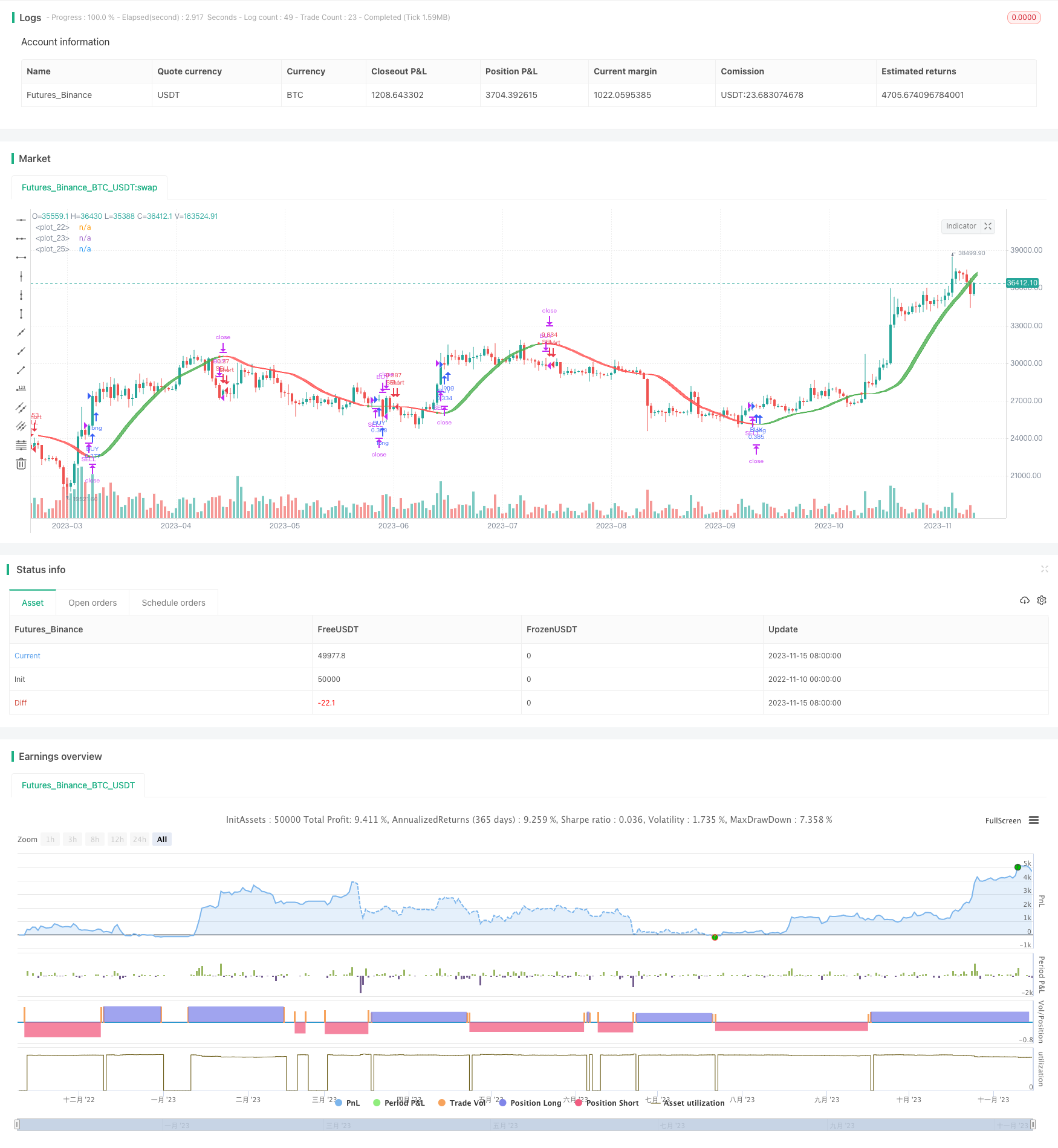
概述
本策略采用动量双均线交叉的方法,实现low risk交易。它使用两个不同周期的均线,快线和慢线,根据它们的交叉去判断买入卖出时机。该策略旨在捕捉趋势的变化,在大趋势中获取长线收益。
策略原理
该策略使用WMA快线和WMA慢线的交叉判断买卖信号。快线周期是慢线周期的一半。当快线从下方上穿慢线时产生买入信号;当快线从上方下穿慢线时产生卖出信号。为过滤假信号,它还引入了一个移动平均线的动量差值指标。只有当快慢线交叉的同时,该指标也符合形态要求时,才会产生交易信号。
具体来说,策略中的关键逻辑有:
定义价格及参数:提取OHLC价格数据;定义参数HullMA周期z、价格数据p。
计算双均线:计算2周期均线n2ma、z周期均线nma。
计算均线差值:计算两均线差值diff。
计算动量指标:计算均线差值的sqn周期移动平均n1、n2、n3。
判断交叉:当n1上穿n2时标记为绿色,否则标记为红色。
绘制形态:绘制n1、n2的图形。
判断信号:三个动量均线n1、n2、n3同向交叉时产生信号。
入场出场:快线上穿慢线且动量指标符合要求时做多;快线下穿慢线且动量指标符合要求时做空。
策略优势
该策略结合双均线交叉和动量指标,可以有效过滤假信号,只在趋势变化开始时产生交易信号,从而获得较好的策略效果。
快线慢线交叉可以判断趋势变化的时机,利用趋势获得收益。
加入动量指标可以过滤假信号,避免被市场的短期涨跌误导。
只在大趋势发生变化时进行交易,可以减少不必要的交易频率。
采用参数优化后的均线周期,可以使指标更符合不同品种的特性。
允许一定程度的 pyreming 可以拉伸盈利周期。
策略风险
该策略也存在一些风险需要注意:
双均线交叉对趋势变化判断有滞后,可能错过价格变化的最佳时机。
动量指标参数设置不当可能对交易产生误导。
存在一定的多空仓持仓时间不均衡问题。
策略对市场的震荡行情没有很好的处理机制。
存在一定的过优化风险,需对参数进行步进优化。
对应风险的解决方法有:
可以考虑加入其他先导指标判断价格变化,提前做准备。
应对动量指标参数进行适当优化,找到最佳参数组合。
可以考虑加入波动率指标帮助控制仓位时间。
可适当限制仓位量,降低单笔亏损。
应进行参数稳健性检验,避免过优化问题。
策略优化方向
该策略还可以从以下几个方面进行优化:
尝试不同类型的均线指标,找到对品种最优的参数。
测试加入其他辅助指标,如MACD、布林带等判别趋势变化。
优化入场时机,准确判断价格反转的起点。
优化出场时机,使用追踪止损等方式锁定利润。
根据不同品种的特性进行参数优化。
利用机器学习方法找到最优参数组合。
构建动态仓位管理机制,控制风险。
添加量化的策略评估指标,如夏普比率、盈亏比等。
利用回测引擎评估策略在历史数据上的表现。
总结
综上所述,该动量双均线策略采用了均线交叉和动量指标判断大趋势的转折点,可以有效过滤噪音实现低风险交易。它具有获利稳定、实现简单等优点,也存在一些参数优化和风险控制方面的问题。我们可以从优化入场出场时机、动态仓位管理等方面进行改进,使策略更适应市场的特性。充分验证和严格评估是保证策略效果的关键。总之,该策略为量化交易提供了一个简单有效的思路,但还需要持续优化和验证,才能产生稳定的投资回报。
/*backtest
start: 2022-11-10 00:00:00
end: 2023-11-16 00:00:00
period: 1d
basePeriod: 1h
exchanges: [{"eid":"Futures_Binance","currency":"BTC_USDT"}]
*/
//@version=2
//OCTOPUS Indicator Strategy
strategy("FAVEL corp. Indicator Strategy", shorttitle="FAVEL corp. Monarch", overlay=true, default_qty_type=strategy.percent_of_equity, max_bars_back=420, default_qty_value=20, calc_on_order_fills= true, calc_on_every_tick=true, pyramiding=0)
z=input(defval=60,title="HullMA cross")
p=input(ohlc4,title="Price data")
n2ma=2*wma(p,round(z/2))
nma=wma(p,z)
diff=n2ma-nma
sqn=round(sqrt(z))
n2ma1=2*wma(p[1],round(z/2))
nma1=wma(p[1],z)
diff1=n2ma1-nma1
sqn1=round(sqrt(z))
n2ma2=2*wma(p[2],round(z/2))
nma2=wma(p[2],z)
diff2=n2ma2-nma2
sqn2=round(sqrt(z))
n1=wma(diff,sqn)
n2=wma(diff1,sqn)
n3=wma(diff2,sqn)
c=n1>n2?green:red
n1e=plot(n1, color=c, linewidth=1, offset=2)
n2e=plot(n2, color=c, linewidth=1, offset=2)
fill(n1e, n2e, color=c, transp=75)
plot(cross(n1, n2) ? n1 : na, style = circles,color=c, linewidth = 4)
closelong = p<p[1] and n1<n3
if (closelong)
strategy.close("BUY")
closeshort = p>p[1] and n1>n3
if (closeshort)
strategy.close("SELL")
longCondition = strategy.opentrades<1 and n1>n2 and p>p[1] and n1>n3
if (longCondition)
strategy.entry("BUY",strategy.long)
shortCondition = strategy.opentrades<1 and n1<n2 and p<p[1] and n1<n3
if (shortCondition)
strategy.entry("SELL",strategy.short)